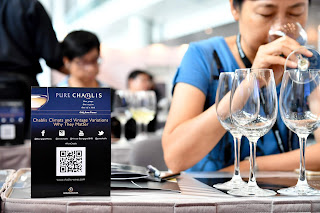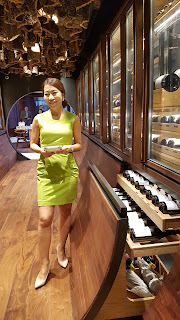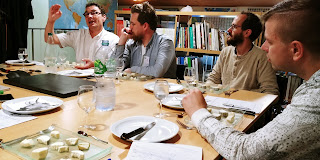 |
| Source: www.bourgogne-wines.com |
It is possible to divide Gevrey into three zones. The first zone starts from the northern side of the Combe Lavaux, continuing along a semi-circular slope into the village of Brochon. (Note that despite being a winemaking village, Brochon is not entitled to its own village appellation. Therefore, the vineyards on the southern side of Brochon, abutting Gevrey, are classified as Gevrey village vineyards. Those at the northern end are classified as either Fixin village wines or Côte de Nuits-Villages wines.) For this first Gevrey zone, vines are planted from 280 metres to around 380 metres near the climat of Combe Aux Moines. The vines either face fully south near Combe Lavaux to fully east at Brochon. The soils are rich in limestone and clay. The vineyards near the top of the slope often have very thin topsoil of marl, around 30 cm. The mid-slope is largely formed from a stratum of crinoidal limestone from the Middle Jurassic period, whereas near the bottom of the slope, it can be around 60 cm of topsoil on marl. Renard noted the presence of fossiled marl from the Bajocian period, Marnes à Ostrea acuminata , at the Premier Cru climats of Clos Saint-Jacques, Lavaux and Poissenot. The soil's high mineral content or its accessibility to minerals for vine roots explains the finesse and structure of these wines.
The second zone largely consists of the alluvial fan that is formed by the Combe Lavaux. At places, the top soil lies above Comblanchien limestone several metres deep that offers good drainage properties. This area accounts for over 50% of Gevrey's production.
The third zone begins from the southern side of the Combe Lavaux, following the hillside curve where the Grand Cru appellations are located, and finally stretching to the border with Morey-Saint-Denis. Most of these vineyards face east, with some village appellation near the top of Combe facing north east. The altitudes are from 260 metres to 300 metres for the Grand Cru climats stretching to 340 metres for the Bel Air climat. A number of prestigious premier cru climats are located near the Grand Cru appellations, including Champonnet, Le Fonteny, Les Corbeaux, La Petite Chapelle and Aux Combottes. The presence of Marnes à Ostrea acuminata is noted here, in particular in the climat of Chambertin.
 |
| Jean-Pierre Renard, L'Ecole des Vins de Bourgogne, BIVB |
Renard gave us an interesting illustration of the notion of terroir. Near the exit of Combe Lavaux, the vineyards on the southern side are less sheltered from the winds and face north east. As a result, Combe de Lavaux and Les Marchais are only classified as village appellation lieux-dits, whereas the vineyards that are on the opposite side of the Combe face fully south and they are classified as Premier Cru climats, for example, Les Verroilles, Lavaux Saint-Jacques, Poissenot and Etournelles.
 |
| Gregory Patriat, Maison JC Boisset (source: www.jcboisset.com) |
Of the 26 premier cru climats, Renard highlighted some renowned ones including Aux Combottes, Les Cherbaudes, Les Corbeaux, Clos Saint-Jacques, Champonnet, Les Cazetiers and Champeaux. He also remarked that a number of winemakers had started to indicate on the labels the lieu-dit for some village level production. Some noteworthy lieu-dit names include Les Corvées, Les Etelois, Les Jeunes Rois and En Songe.
A village with so much prestige to its name has only the reputation of its wines to defend and sustain. The current generation is working hard at ensuring the quality of the soils. Nicolas Rossignol of Domaine Rossignol-Trapet mentioned the increased use of ploughing to work the soils and control the vegetative growth around the vines, to give the soils better aeration and improved organic content of the topsoil. The village now has about 8 domaines certified organic or biodynamic, evidence that the growers are keen to preserve nature for the sustainability of this prestigious heritage.
This unique delivery of masterclass finished with a tasting of six wines, from one village lieu-dit and six premier cru climats of Gevrey. In fact the lieu-dit is Clos Prieur, which is partly a village lieu-dit and partly a premier cru, below Mazis-Chambertin.
The six wines were:
Gevrey-Chambertin Clos Prieur, 2016, Domaine Marc Roy
Gevrey-Chambertin Premier Cru les Cherbaudes, 2015, Domaine des Beaumont
Gevrey-Chambertin Premier Cru Clos du Chapitre, 2015, Nuiton-Beaunoy
Gevrey-Chambertin Premier Cru Lavaux Saint-Jacques, 2016, Domaine Harmand-Geoffroy
Gevrey-Chambertin Premier Cru Les Champeaux, 2016, Domaine Henri Magnien
Gevrey-Chambertin Premier Cru Les Cazetiers, 2016, Domaine Henri Magnien
Being faithful expressions of their climats and vintages, the six wines all varied in styles. Some showed more violet and darker fruit, others more red fruit and roses. Oak was overall very well-managed and was nicely integrated, even for the three younger Premier Cru wines from 2016. All three wines showed an invigorating freshness and a classic vibrancy, while flaunting some lovely ripe fruit, a generous mid-palate and long finish. It was indeed difficult for us to choose a favourite. However, the most votes did go to the Lavaux Saint Jacques by Domaine Harmand-Geoffroy, followed by the Les Cazetiers by Domaine Henri Magnien. Les Champeaux by Domaine Henri Magnien and Les Cherbaudes by Domaine des Beaumont shared an equal third.
Kudos to this new generation of winemakers in Gevrey for having made these high quality and expressive wines. Their work has enabled us to appreciate the nuances of the climats and the rich diversity of Gevrey-Chambertin. Gevrey was a village made by the prestige of Chambertin but its future is a living tale of application, sensibility and persistence of its men and women.
Thank you BIVB for allowing me to host this masterclass and to share this experience with our trade and media friends in Hong Kong. #BIVBRDV
















































